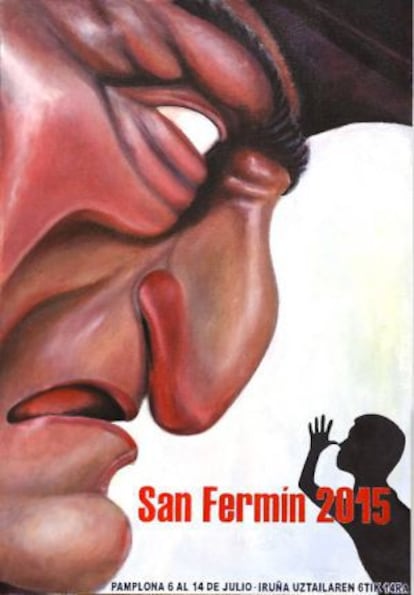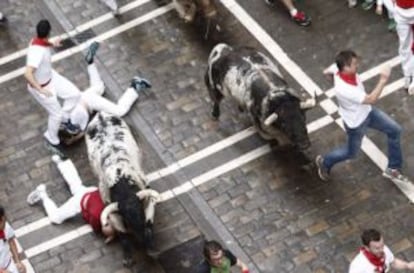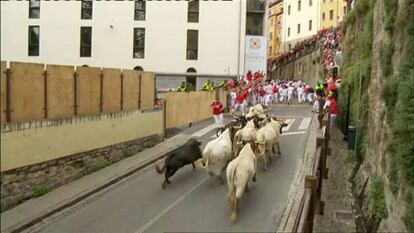Rev up your engines – it’s time for the annual Running of the Bulls
An insider’s guide to the best and the lesser-known options for a good time in Pamplona
It’s that time of the year again. The Sanfermines, better known as the Running of the Bulls in the English-speaking world, became internationally famous thanks to a certain Nobel literature prize winner, Ernest Hemingway, who used to eat eggs with the locals at Casa Marceliano, a bar that no longer exists but was once located near the Santo Domingo hill.
Held in the Navarrese capital, Pamplona, the event sinks its roots in medieval times and is steeped in tradition, but the new mayor of Pamplona to emerge from May 24 elections, Joseba Asirón of the radical left-wing group EH Bildu, has decided to make some changes this year.
Passage from adolescence to adulthood takes place on the day when locals first utter the sentence: “I like San Fermín better by day than by night”
Most notably, responsibility for the chupinazo – the rocket that is set off from City Hall at noon on July 6 to mark the official opening of the fiesta – will not be awarded to a politician with representation in the local council.
Instead, the people in charge of this momentous event will be representatives of the Orfeón Pamplonés, a local choir that is celebrating its 150th anniversary this year, and the successors of Peña La Veleta, a social club that pioneered the use of the red-and-white outfit that now symbolizes the Sanfermines.
Between July 6 and 14 the white shirt, white pants and red neckerchief worn by most revelers will play a democratizing role in Pamplona, where political ideology can be a deeply divisive factor the rest of the year.
San Fermín with kids in tow

Another noticeable change this year is the attempt to attract more families with kids. Typically, many local parents choose to spend the week elsewhere to avoid the crowds, the drunkenness and the general mayhem. In Salou, a Catalan sea town with a significant Navarrese migrant population, a lot of people can be seen nostalgically setting off their own rockets on the promenade at this time of the year, while others pretend to be running from a bull on the beach.
The poster selected for this year’s Sanfermines references childhood fiestas: in it, a child mocks Caravinagre, literally Vinegar Face, a scary character who figures prominently in the Gigantes y Cabezudos (Giants and Big-Heads) parade.
Another tradition that goes back to medieval times, the Gigantes y Cabezudos parade takes place every morning during Sanfermines, and the paraders are followed by a crowd of bleary-eyed parents pushing kiddie strollers or carrying children on their shoulders. The city has developed a mobile app called San Fermín Pamplona, which includes the GPS location of the parade, a useful tool for late risers.
In the afternoons, a classic family option is the impromptu amusement park that goes up on the banks of the Arga river, in the neighborhood of Rotxapea. Before graduating to real theme parks, generations of Pamplona children have cut their teeth on this rollercoaster and memorized the little tunes blared out of the raffle stand.
At 11pm, there is also a fireworks competition in Ciudadela park that became part of the international circuit over a decade ago.
San Fermín is a daytime event
For natives of Pamplona, or pamplonicas, the passage from adolescence to adulthood takes place on the day when they first utter the sentence: “I like San Fermín better by day than by night.”
Daytime activities can begin very early indeed if one is willing to participate in the most famous of the Sanfermines event, the encierro or running of the bulls, which starts at 8am every morning of the festival. This, however, requires some degree of fearlessness and good early planning.

If you would would rather watch from the sidelines, a good option is renting out space on one of the balconies that line the 849-meter run. Many spots can be had for anywhere between €30 and €80, and come with a complimentary breakfast. And then there are the fortunate souls with friends who own a property on Estafeta street, and have to pay nothing beyond paper cones filled with hot churros to share with their hosts.
Another early morning tradition is the Baile de la Alpargata (literally the Espadrille Dance), held every day at the Rococo-style hall of the New Casino, on Plaza del Castillo. Invitations are required, but those who make it inside will see a mix of tradition-loving families and late-night partiers who are not quite ready to go to bed yet. Illustrious past visitors include former NBA player Dennis Rodman.
The red-and-white outfit worn by most revelers plays a democratizing role in Pamplona, where political ideology can be a divisive factor the rest of the year
For those wishing to get some inside stories about the encierros, a good place to keep one’s ears open is Casa Paco, where many runners come for a mid-morning snack, or the churro shop La Mañueta, which has been making the popular fritters using a wood fire for more than 100 years.
But all the activities should not stop visitors from enjoying Pamplona’s remarkable gastronomical offer. High-end establishments like Restaurante Europa or El Rodero require reservations, but the tapas bars are very good option for quality, affordable food with a genuine feel. Before that, however, sample the red vermouth at any of the bars around Plaza del Castillo.
It’s bulls in the morning and bulls in the afternoon, but this time inside the ring. This is the only bullring in Spain that gets completely filled up every single day of the fiestas – and it seats 20,000. Outside, 16 social clubs and their marching bands add to the general confusion with a combination of sound and imagery that is impossible to depict in words. The best way to keep up with the party is to follow one of these bands back to their headquarters, most of which are located on Jarauta street, where the end of the day’s reveling blends in smoothly with the beginning of the nighttime partying.
San Fermín at night
Newcomers to the Sanfermines usually end up in Plaza del Castillo, the city’s main square, and it is easy enough to spend the whole night there without going elsewhere. Besides all the bars, many of the open-air concerts are held here. This year, guest performers include Medina Azahara, Celtas Cortos and Alejo Stivel.
Newer bands will take the stage at Plaza de los Fueros, with a lineup featuring The Wailers, Nancys Rubias, Mclan and Boni, a member of a very popular local band called Barricada.
But the night is not only for the young. The young at heart have more peaceful places to enjoy a drink and a chat, such as the sidewalk cafés of Ensanche. The local swimming club and the two casinos even hold verbenas, a kind of fair that was hugely popular in the 19th century.
Ultimately, any corner of the city can become a good place to enjoy one’s time in Pamplona. Because if there is something that holds true year after year, it is that the best Sanfermines are the ones that are not planned ahead of time.
English version by Susana Urra.
Tu suscripción se está usando en otro dispositivo
¿Quieres añadir otro usuario a tu suscripción?
Si continúas leyendo en este dispositivo, no se podrá leer en el otro.
FlechaTu suscripción se está usando en otro dispositivo y solo puedes acceder a EL PAÍS desde un dispositivo a la vez.
Si quieres compartir tu cuenta, cambia tu suscripción a la modalidad Premium, así podrás añadir otro usuario. Cada uno accederá con su propia cuenta de email, lo que os permitirá personalizar vuestra experiencia en EL PAÍS.
¿Tienes una suscripción de empresa? Accede aquí para contratar más cuentas.
En el caso de no saber quién está usando tu cuenta, te recomendamos cambiar tu contraseña aquí.
Si decides continuar compartiendo tu cuenta, este mensaje se mostrará en tu dispositivo y en el de la otra persona que está usando tu cuenta de forma indefinida, afectando a tu experiencia de lectura. Puedes consultar aquí los términos y condiciones de la suscripción digital.
Archived In
Últimas noticias
Most viewed
- Oona Chaplin: ‘I told James Cameron that I was living in a treehouse and starting a permaculture project with a friend’
- Sinaloa Cartel war is taking its toll on Los Chapitos
- Reinhard Genzel, Nobel laureate in physics: ‘One-minute videos will never give you the truth’
- Why the price of coffee has skyrocketed: from Brazilian plantations to specialty coffee houses
- Silver prices are going crazy: This is what’s fueling the rally









































